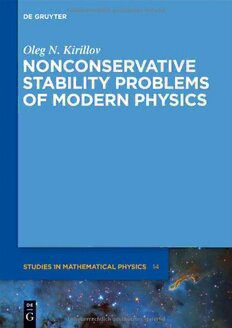
Nonconservative Stability Problems of Modern Physics PDF
Preview Nonconservative Stability Problems of Modern Physics
De Gruyter Studies in Mathematical Physics 14 Editors MichaelEfroimsky,Bethesda,USA LeonardGamberg,Reading,USA DmitryGitman,SãoPaulo,Brasil AlexanderLazarian,Madison,USA BorisSmirnov,Moscow,Russia Oleg N. Kirillov Nonconservative Stability Problems of Modern Physics De Gruyter PhysicsandAstronomyClassificationScheme2010: 02.30.Oz,02.30.Tb,02.40.Yy,03.65.Vf, 05.45.-a,45.20.-d,45.30.+s,46.40.-f,47.20.-k,47.65.-d. Author Dr.OlegN.Kirillov Helmholtz-ZentrumDresden-Rossendorf InstitutfürFluiddynamik AbteilungMagnetohydrodynamik Postfach510119 01314Dresden Germany [email protected] ISBN978-3-11-027034-1 e-ISBN978-3-11-027043-3 Set-ISBN978-3-11-027044-0 LibraryofCongressCataloging-in-PublicationData ACIPcatalogrecordforthisbookhasbeenappliedforattheLibraryofCongress. BibliographicinformationpublishedbytheDeutscheNationalbibliothek The Deutsche Nationalbibliothek lists this publication in the Deutsche Nationalbibliografie; detailedbibliographicdataareavailableintheInternetathttp://dnb.dnb.de. © 2013WalterdeGruyterGmbH,Berlin/Boston Typesetting:PTP-BerlinProtago-TEX-ProductionGmbH,www.ptp-berlin.de Printingandbinding:Hubert&Co.GmbH&Co.KG,Göttingen Printedonacid-freepaper PrintedinGermany www.degruyter.com TothememoryofmyparentsAlevtinaandNikolai Preface Hubs are special. They dominate the structure of all networks in which they arepresent,makingthemlooklikesmall worlds.WhiletwopagesontheWebare 19clicksaway,Yahoo.com,agianthub, isreachablefrommostWebpagesin2to 3clicks.Fromtheperspectiveofthehubs theworldisindeedverytiny. A.-L. BarabaKsi, Linked Almosthalfacenturyago,theseminalbookbyV.V.Bolotin,Nonconservativeprob- lems of the theory of elastic stability, came into print [75]. It summarized the expe- rienceofengineersintheanalysisofnonconservativesystemsaccumulatedsincethe 1920swhenthefirstattemptstotakeintoaccountdissipativeeffectsinrotordynam- icsandtoexplainsuchdangerous instabilities asaerodynamicflutterandshimmyin aircraftlandinggearwereundertaken.Despitethemanyexcellentbooksonstability theorythatwerepublishedduringthenextfiftyyears[22,60,121,127,141,150,162, 168,182,213,239,346,367,369,371,394,400,412,423,437,470,503,518,528,570, 590,626],Bolotin’smonographstillremainstheonlyonedevotedsolelytothemeth- ods and challenges of nonconservative stability. Its only drawback is that this book cannottakeintoaccountthedramaticdevelopmentsinmathematics,engineeringand physicsthathavebeenmadesince1963. Thebook[75]wasmotivatedmainlybytheproblemsofstabilityofslenderstruc- turesunderfollowerforcesandofrotatingflexibleshafts.Alreadythesemodelsdeal with the two fundamental nonconservative perturbations – viscous dissipation and nonpotentialpositionalforces[332,333]. Last five decades extended considerably the range of applications in which such nonconservative forces play a crucial role. We mention friction-induced instabilities causing the flipping of the tippe top [84] and the problems of the acoustics of fric- tionrelatedtotheexcitationofaudiblevibrationsinbrakesandclutches[268],paper calenders [92,537], prostheses of hip joints [255] and even in the singing glasses of BenjaminFranklin’sglassharmonica[6,293]. viii Preface Nonconservative models appear in modern studies of landslides on gentle slopes when the constitutive relation of a nonassociated geomaterial, such as loose sand, is describedbyanonsymmetricmatrix[59,60,117]. Inhydrodynamicsandplasmaphysics,thecounter-intuitivedestabilizinginfluence ofdissipationonnegativeenergywaves[115,168,446,552]isanimportantingredi- ent in the theories of boundary layer [349], flow control [111,112,171] and stabil- ityofwavepropagation[90].Inrotatingfluids,interplayofthenonconservativeand gyroscopic forces may lead to the paradoxical discontinuous change in the stability boundary as happens in the case of the baroclinic instability when the Ekman layer dissipationisinfinitesimallysmall[334,501,563]. Inmagnetohydrodynamics,theVelikhov–Chandrasekharparadox[120,581]occurs in the theory of magnetorotational instability when for infinite electrical conductiv- ity of the differentially rotating fluid the limit of the vanishing axial magnetic field does not trace back to the Rayleigh threshold of hydrodynamics [1,28,199]. Non- conservativeforcesplayanincreasingroleincelestialmechanics,e.g.,inthemodeling oftetheredsatellitesystems,satelliteandplanetaryrings[43,44,87]. Arichsourceofnonconservativeproblemsismodernroboticsandautomaticcon- trol [41] and biomechanics [216] – for example, the spine is frequently modeled as a column loaded by a distributed follower force [500]. Of course, traditional areas such as aerospace engineering and structural mechanics remain one of the biggest consumersofthenonconservativestabilitytheory[224,240]. Alreadyinthe1960sBolotinemphasizedthatprogressinthenonconservativesta- bilitytheorydependsondevelopmentsinthetheoryofnonself-adjointoperators.Im- portantcontributions tothelattermotivatedmainlybymechanicalapplications were made,e.g.,inthe1940sbyS.L.Sobolev[536]andL.S.Pontryagin[483],inthe1950s byM.V.Keldysh[261]andM.G.Krein[336,337]andsincethenbymanyotherau- thors. Theneedsofoptimaldesignandrationalexperimentplanningrequiredconsidera- tionofmultiparameterfamiliesofnonself-adjoint boundaryeigenvalueproblems.In the 1970s, the studies by V.I. Arnold and his co-workers established a sharp corre- spondencebetween themultiple eigenvalues ofnonsymmetric matricesandgeomet- ricsingularities ontheboundaryoftheasymptotic stabilitydomainofamatrixfam- ily[17,18,374,375].Animmediateconsequenceofthisresultistheresolutionofthe famous Ziegler’s paradox (1952) of destabilization of a reversible system by small dissipation[622]bymeansoftheWhitneyumbrellasingularity,whichwasdonein- dependentlybyanumberofauthorsstartingwithO.Bottemain1955–56[80,81]. Sincethe1950s,theconceptofthesymplecticorKreinsignatureofeigenvalueshas beenwidelyusedinhydro-andmagnetohydrodynamicstodescribewavesofpositive andnegativeenergy[264,320,390,392,606,607].Inthe1990s,theinfluenceofnon- HamiltonianperturbationsonthestabilityofHamiltoniansystemsbecameatopicfor a systematic investigation [391,395] that gave birth to the area of research known Preface ix as ‘dissipation-induced instabilities’ [74] – a concept that touches a broad variety of physicalapplications[333]. Thoughveryexcellent,anetworkoftheseresultsischaoticallyscatteredatpresent throughout the specialized journals. Many brilliant physical phenomena that could crown the nonconservative stability theory are almost unknown to the stability the- orists with a classical mechanical background. On the other hand, achievements of the theory of nonself-adjoint operators [421,611], the theory of operators in the spaces with indefinite metric (Krein and Pontryagin spaces) [202], Lidskii–Vishik– Lyusternikperturbationtheoryformultipleeigenvalues[428],theoryofmultiparam- etereigenvalueproblems[24,585],modernresultsofappliedlinearalgebra[576]as wellassingularitytheoryappeartobestillnotfamiliartomanyengineers,physicists andevenstabilitytheoristsworkingwithnonconservativestabilityproblems. However, the combination of these approaches of modern applied mathematics withthecomplexfundamentalnonconservativephenomenaofphysicsandmechanics seemstobetheonlywaytounderstandthelatterandtocreatearathercompleteand unifiedconstructivetheoryofstabilityofnonconservativesystemsandofdissipation- inducedinstabilities.Thatiswhythereisastrongneedforadetailedexpositionwhich wouldbringtogetherthescatteredresultsofthelastfiftyyearsandwhichwoulden- deavortounifyandtosystematizeboththeresultsandthemethodsoftreatmentofthe nonconservativestabilityproblemsofmodernphysics.Thisbookisanattempttofill thisneed. In it an effort is made to present the subject of nonconservative stability from the modernpointofviewascompletelyaspossiblewithintheallottedspace.Itpresents relevantmathematicalconcepts,bothalreadyfamiliarandthenewonesforthissubject aswellasrigorousstabilityresultsandnumerousclassicalandcontemporaryexamples from mechanics and physics. The book is substantially based on the results of the author;althoughbynecessityitcontainssomeresultsofotherauthorswithoutwhich it is impossible to create a self-consistent exposition. It is hoped that this book will serve the present and prospective specialist in the field by acquainting him with the currentstateofknowledgeinthisactivelydevelopingfield. Thebook has 12 chapters. After anumber of examples accompanied by ahistori- caloverviewintheIntroduction,thefirstsixchaptersdealwiththefinitedimensional nonconservativesystems,whiletherestofthebookisdedicatedtotheinfinitedimen- sional ones. Naturally, the first part of the book contains fundamentals of the theory andmoregeneralresultsbecauseofthewidevarietyofmathematicaltoolsavailable in finite dimensions. The center of gravity in the second part is shifted to studies of concretephysicalproblems.Allchapterscontainillustrativephysicalexamples. I would like to express my warmest gratitude to all the colleagues and collabo- rators whose support, friendly advice, encouraging discussions and fruitful joint re- search were among the main inspirational factors driving my work on this project: Abd Rahim Abu Bakar, Sergei Agafonov, Vadim Anischenko, Teodor Atanack- ovic, Vladimir Beletsky, Carl Bender, Michael Berry, Noël Challamel, Gengdong x Preface Cheng,RichardCushman,FelixDarve,BarbaraDietz,MikhailEfroimsky,Yasuhide Fukumoto,GunterGerbeth,ValentinGlavardanov,YuanxianGu,Eva-MariaGraefe, Samvel Grigorian, Uwe Günther, Peter Hagedorn, Hanns-Ludwig Harney, Daniel Hochlenert, Norbert Hoffmann, Igor Hoveijn, Wolfhard Kliem, Anthony Kounadis, Yuri Leschinski, Alexei Mailybaev, Vadim Marchenko, Jerrold Marsden, Maxim Miski-Oglu, OliverO’Reilly,HuajiangOuyang, PauliPedersen,DmitryPelinovsky, AlexandraPerlova,KarlPopp,AchimRichter,IngridRotter,FlorianSchäfer,Guido Schneider, Alexander Seyranian, Sergei Sorokin, Gottfried Spelsberg-Korspeter, FrankStefani,FerdinandVerhulst,AlexanderZevin,andMiloslavZnojil. IlearnedalotfromthelecturesandseminarsgivenduringmystudiesattheMoscow Institute of Physics and Technology in 1989–1995 by Alexander Abramov, Oleg Besov,BorisFedosov,VictorGalactionov,VictorLidskii,BorisRauschenbach,Vic- tor Zhuravlev, and other brilliant professors and lecturers of my Alma Mater whose enthusiasticworkinthe‘stormy1990s’inRussiawasanimpressiveexampleofano- blededicationtostudentsandtheprofessionthatdeeplyinfluencedmyformationasa scientist. I thank the Russian Foundation for Basic Research (RFBR, Russia), the National NaturalScienceFoundationofChina(NSFC,China),INTAS(EU),theCivilianRe- search and Development Foundation (CRDF, USA), the Alexander von Humboldt Foundation (Germany), Deutsche Forschungsgemeinschaft (DFG, Germany), Saxon Ministry of Science (Germany) and the Japan Society for the Promotion of Science (JSPS,Japan)fortheirmostvaluablefunding. IamindebtedtomywifeKseniaandtomydaughterMarinaandsonNikolaiwho generouslygiftedmetime,support,andunderstanding. Dresden,12April2012
